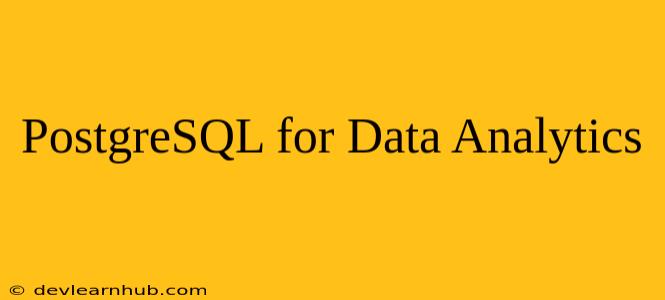Introduction
PostgreSQL, a robust and open-source relational database management system (RDBMS), has gained significant traction in the data analytics landscape. Its powerful features, reliability, and rich ecosystem make it an ideal choice for handling complex analytical workloads. This article delves into the strengths of PostgreSQL as a data analytics tool, exploring its key capabilities and how it empowers organizations to extract meaningful insights from their data.
PostgreSQL's Advantages for Data Analytics
1. Data Integrity and Consistency
PostgreSQL's commitment to ACID (Atomicity, Consistency, Isolation, Durability) properties ensures data integrity and consistency. This is paramount for analytics, as it guarantees that the insights derived from the data are accurate and reliable.
2. Powerful Query Language and Functions
PostgreSQL supports SQL, the standard language for interacting with relational databases. Its advanced features, such as window functions, recursive queries, and aggregate functions, provide immense flexibility and power for data manipulation and analysis.
3. Extensibility and Customization
PostgreSQL offers a wide range of extensions, which extend its functionality and cater to specific analytical needs. For instance, extensions like PostGIS enable spatial analysis, while pg_cron facilitates scheduled data processing. This extensibility allows users to tailor PostgreSQL to their unique analytical requirements.
4. Data Types and Data Modeling
PostgreSQL provides a comprehensive set of data types, including numeric, text, date/time, geometric, and JSON, which effectively capture diverse data characteristics. Its support for inheritance and constraints enables the creation of robust and well-structured data models, crucial for accurate analysis.
5. Data Storage and Scalability
PostgreSQL offers various storage options, including disk-based and in-memory, allowing users to optimize performance based on their analytical needs. Additionally, its support for replication and partitioning enables scalability, handling large datasets and high-volume queries efficiently.
6. Rich Ecosystem and Community Support
PostgreSQL benefits from a vibrant community and ecosystem. Its widespread adoption has fostered the development of numerous tools and resources, including data visualization libraries, analytics frameworks, and cloud-based services, further enhancing its capabilities for data analytics.
Key Capabilities for Data Analytics
1. Data Aggregation and Summarization
PostgreSQL's aggregate functions (e.g., SUM, AVG, COUNT) enable the summarization of data, providing valuable insights into trends, patterns, and outliers. These functions are essential for understanding data distributions and generating statistical summaries.
2. Data Transformation and Cleaning
PostgreSQL offers a range of functions for data transformation and cleaning, such as string manipulation, data type conversion, and data validation. These functions are critical for preparing data for analysis, ensuring data quality and consistency.
3. Data Exploration and Visualization
While PostgreSQL itself is not a visualization tool, it integrates seamlessly with various data visualization libraries and frameworks. By extracting data from PostgreSQL, users can generate insightful charts, graphs, and dashboards using tools like Tableau, Power BI, and Python libraries (e.g., Matplotlib, Seaborn).
4. Time Series Analysis
PostgreSQL excels in time series analysis, thanks to its robust support for date and time data types. It allows users to perform time-based calculations, analyze trends, identify seasonality, and forecast future values.
5. Spatial Analysis
With the PostGIS extension, PostgreSQL can handle spatial data, enabling spatial analysis and querying. This is crucial for applications like location-based services, geographic information systems (GIS), and environmental modeling.
Use Cases for PostgreSQL in Data Analytics
PostgreSQL finds applications across various industries and analytical domains:
1. Business Intelligence (BI)
PostgreSQL powers BI systems by providing a reliable and performant data source. It enables organizations to analyze sales data, customer behavior, and market trends to make informed business decisions.
2. Customer Analytics
PostgreSQL supports the analysis of customer data, helping organizations understand customer preferences, segmentation, and churn patterns. This knowledge empowers businesses to improve customer engagement and satisfaction.
3. Financial Analysis
PostgreSQL is widely used in financial institutions for analyzing financial data, detecting fraud, and predicting market movements. Its accuracy and scalability make it a trusted tool in the financial sector.
4. Healthcare Analytics
In healthcare, PostgreSQL helps analyze patient data to improve diagnoses, optimize treatment plans, and monitor patient outcomes. Its data integrity and privacy features are crucial in the sensitive healthcare domain.
5. Research and Development
PostgreSQL supports research and development by providing a platform for data analysis, modeling, and simulation. Researchers leverage its capabilities to explore complex datasets and derive scientific insights.
Conclusion
PostgreSQL is a powerful and versatile tool for data analytics, offering a combination of features and capabilities that make it an ideal choice for organizations of all sizes. Its robust data integrity, comprehensive query language, extensibility, and thriving ecosystem empower users to extract meaningful insights from their data, driving informed decision-making and achieving strategic goals. As data volumes continue to grow, PostgreSQL remains a reliable and scalable solution for tackling complex analytical challenges and unlocking the true potential of data.
